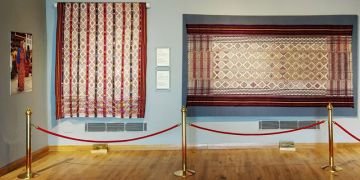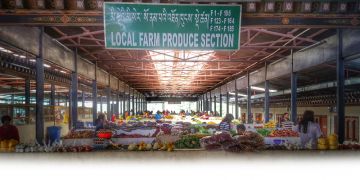Authentic Bhutanese Craft bazaar in Thimphu sits along the Norzin Lam stretching from the Taj Tashi hotel up till Royal textile academy of Bhutan.
Authentic Bhutanese Craft bazaar in Thimphu sits along the Norzin Lam stretching from the Taj Tashi hotel up till Royal textile academy of Bhutan. The market consists of around 80 shops which are entirely made of bamboo huts aligned together along the Norzin Lam covering about half a kilometer of the road. Bhutan had its first craft bazaar or handicraft market in 2011 in Thimphu.The craft bazaar was initiated to promote the young talented rural based artists who master the arts and crafts of the age-old Bhutanese traditional arts which were passed down from generations. It offers a platform for these young entrepreneurs from remote communities, from all over the country to showcase their art and craftworks. The most important and the foremost aim of this initiative is to improve the socio-economic status of these rural-based communities. The shoppers will enjoy the stroll through this bazaar and will find at least a thing or two to take with them as souvenirs to remind them of their enchanting voyage through Bhutan.
Timings:
Open on: Wednesday - Monday
Closed on: Tuesday
Opening time: 9AM – 5PM
What to look for at the craft Bazaar: (products)
- Hand-woven stoles /Gho and kira
- Popular yathra items from Bumthang
- Traditional Thangka paintings
- Wooden bowls & utensils
- Wooden carvings
- Locally handmade paper (desho)
- Slate/stone carvings
- Traditional masks
- Brass/bronze statues
- Wooden bowls/other household items
- Religious items
- Hand-woven/ stitched bags
Why shop at craft bazaar?
Probably wondering why this market is one of the best places to shop for souvenirs in Thimphu? Exactly! getting to that, the craft bazaar in Thimphu also known as the Handicraft market provides a wide range of traditional craft items all in one place not having to run from one end of the town to the other. The shopkeepers, usually the artists themselves display their products in the shop and who better people to explain their products than the makers themselves. These shopkeepers are excitingly friendly and polite. Travelling on a tight budget? Want to take souvenirs or small gifts for loved ones back at home? The craft bazaar is the place. Why? Firstly you can bargain with the makers which you cannot do at other handicraft shops. Why? Because these retail handicrafts basically buy their products from these artists in order to make profit and will probably sell the same items for a little higher price. Secondly the products at the craft bazaar are much cheaper. Unlike other handicrafts from around the world, Bhutanese handicrafts have unique cultural backgrounds to each and every item.
How are Bhutanese handicrafts unique from that of its neighboring countries’?
The Bhutanese handicrafts deeply reflect its unique culture and tradition which are a direct representation or similar depictions of the zorig chusum. You are probably wondering what zorig chusum is: well, zorig chusum directly translates to 13 arts and crafts of Bhutan. Zorig chusum was first introduced to Bhutan by Terton pema lingpa in the 15th century.since then these different arts and crafts have been passed on to generations by the ancestors. So, what are they?
The 13 arts and crafts are as follows:
- Parzo:it is the art of carving onto woods, slates or stones, the carving are usually of religious idols or texts,religious masks and traditional Bhutanese alter.
- Shagzo: The art Making of bowls, cups, and other containers.
- Shingzo: carpenters who are usually employed as building of dzongs and Bhutanese houses.
- Dezo: The art of making handmade paper made mainly from the Daphne plant. The handmade paper was used for writing religious text and manuscripts.
- Dozo:stone arts or works are mainly used for building dzongs (fortresses) ,walls,pools.
- Garzo: blacksmiths who make farm tools, knives, swords, and utensils.
- Jinzo: The art of making religious statues and, pottery and the construction of Bhutanese houses with clay.
- Lhazo: (art of painting)also known as Lhadrip, is the art of painting religious representations on cloths called thangkas,painting the walls of temples and dzongs with religious images, statues and the windows,walls,doors of Bhutanese houses.
- Lugzo: (art of bronze casting) Production of bronze statues, religious ritual items,bronze jewelry and other bronze household items.
- Thagzo:(art of weaving) It is the art of weaving clothes, specially the national dress of Bhutan, gho and Kira. The clothes woven in Bhutan are considered the most intricately woven fabrics produced in Asia.
- Trozo: (gold smith,silver smith)The art of making silver and gold jewelries and other household items.
- Tshazo: (art of weaving bamboo) the production of such varied items as bows and arrows, baskets, drinks containers, utensils, musical instruments, fences, and mats.
- Tshemzo: (art of tailoring) Working with needle and thread to make clothes or stitching the most intricate thangkas.







